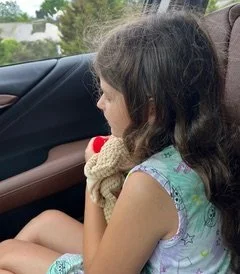Backed by Science, Built on Heart
One in four children in the United States—more than 16 million—live with the impact of a parent’s substance use disorder, yet very few ever receive meaningful support. Research is clear: early, trauma-informed intervention changes lives. Without it, toxic stress and disrupted attachment can lead to anxiety, depression, substance misuse, and the continuation of pain across generations.
I know this pain firsthand. Decades ago, when my children’s father struggled with substance use disorder, I searched for a way to help my kids make sense of the chaos. There were no tools to help me explain what was happening, nothing that reduced the stigma or eased the shame. I wanted them to feel supported and to know it wasn’t their fault. Instead, we were met with silence—and that silence left its own mark.
Lambi Learns was created to fill that silence, building a bridge between lived experience and the science of healing. As Fred Rogers said, “What is mentionable is manageable.” Lambi offers children age-appropriate tools to name their feelings, calm their bodies, and rebuild trust. It also gives caregivers, educators, and community partners a shared language for safety and connection to help children and families bring difficult experiences into the open, transforming silence and stigma into understanding, healing, and hope.
Experts and Lambi Integration
Trauma is held in the body, not just the mind. True healing requires more than words. It requires body-based tools, emotional attunement, and safe relationship to reconnect with self and others. Lambi incorporates somatic-based activities such as butterfly hugs, breathwork, and grounding to help children regulate their nervous systems in developmentally appropriate ways.
Trauma thrives in silence and secrecy, while healing happens through connection and narrative. Lambi helps break the silence around family addiction and helps children feel safe, seen, and supported. By gently naming hard truths, Lambi reduces shame and fosters connection. Telling the truth, in the presence of compassion, is a pathway to healing.
Internal Family Systems teaches that healing involves understanding and accepting the different "parts" of the selfrather than trying to suppress them. Lam bi creates space for chifdren to notice their thoughts and feelings without judgment. By helping them name emotions such as worry, anger, or sadness as parts of their experience - not all of who they are - the story supports early self-compassion and integration.
Trauma fragments the self, leaving behind parts that carry shame, fear, or survival strategies. Healing requires befriending these parts and helpin those parts feel safe. Through gentle storytelling and reflection, Lam bi normalizes emotional complexity and helps children see that their feelings and reactions are valid. The story encourages kindness toward themselves and reduces the shame often left in trauma's wake
Integration across brain regions and emotional attunement are essential for healing from trauma. Naming feelings and linking them to body cues supports emotional regulation. Lambi models this through a narrative that helps children gently notice sensations and emotions while feeling connected and safe.
Polyvagal Theory explains how trauma traps the nervous system in fight, flight, or freeze states. Regulation begins when the body feels safe enough to shift into calm and connection. Lam bi uses rhythmic cues, soft visuals, and sensory language to help engage the parasympathetic system and support safety.
The body stores trauma through posture, movement, and physical tension. Lambi invites children to gently move and stretch, or hug their plush character, as part of engaging with the story, offering somatic release alongside emotional awareness.
Trauma overwhelms the body's ability to process experience.Healing happens through slow, incremental engagement with emotions. Lambi introduces manageable, non-threatening emotional prompts that help children process feelings, one small step at a time.
Trauma fragments a child's sense of self and time, often resulting in dissociation or hypervigilance. The Lambi story emphasizes present-moment sensory details and gentle repetition to help anchor children in the here and now.
Relational experiences in early life shape a child's ability to reulate emotions. Lambi's tone, pacing, and emotionally consistent narrative serve as a model for co-regulation, even m the absence of a physically present caregiver.
Attachment creates the foundation for resilience. Secure, responsive relationships help children manage stress and build confidence. Lambi's story reinforces this by showing characters responding with care, understanding, and predictability
Trauma recovery involves accepting bodily signals without fear or shame. Lam bi gives children language to describe what they feel inside, helping them understand that their reactions are normal and nothing to be ashamed of.
Supportive caregiving, even in high-adversity situations, fosters long-term emotional health. Lambi uses affirming language and small moments of praise to help children internalize a sense of self-worth and stability.
A strengths-based approach builds hope and momentum in healing. The Lambi story highlights the child's agencywhat they can do, what helps them feel better-reinforcing empowerment through choice and self-trust.
Mindfulness teaches children to notice what's happening without being overwhelmed. Lambi offers simple, calming invitations to pause, breathe, and notice the world around them, practices that gently support emotional balance.
Breaking Isolation, Building Resilience.
There is healing power in simply telling the story - bringing into the open what is so often stigmatized, silenced, or hidden. For children experiencing parental addiction, trauma, or loss, the Lambi book depicts their situation in an ageaappropriate, compassionate way, sending a clear message: You are not alone. You are not to blame. And you can feel better, even in hard times.
This alone - breaking the isolation, normalizing the experience, and offering language and validation - directly reduces shame, supports emotional processing, and helps children move toward resilience.











